|
Revision G of tower standard focuses heavily upon tower climbing safety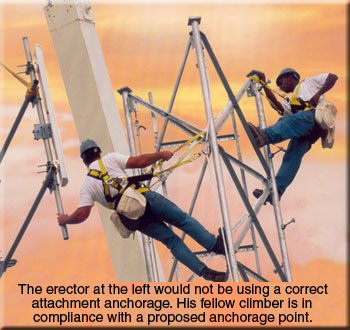
With 432 pages, the new standard for Antenna Supporting Structures and Antennas, TIA-222-G with four addendums, eclipses Revision F's 115 pages with information and expanded content that covers technical issues such as wind and ice loading, seismic loading, design stresses and geotechnical requirements.
For the first time in the standard's history beginning in 1959, tower safety and climbing considerations are emphasized in detail.
Effective January 1, 2006, the standard addresses climber attachment anchorages on structures as an anchorage point for attaching a lanyard or similar fall protection device. Over the years there have been numerous recorded deaths and injuries resulting from the 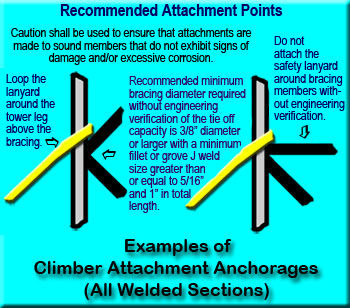 erector tying off to bracing or other members that were not bolted in place or were incapable of supporting the applied force. erector tying off to bracing or other members that were not bolted in place or were incapable of supporting the applied force.
OSHA defines anchorage as "a secure point of attachment for lifelines, lanyards, or deceleration devices." Subpart M, 1926.502(15), in part, states that "anchorages used for attachment of fall arrest equipment shall be independent of any anchorage being used to support or suspend platforms and capable of supporting at least 5,000 pounds (22.2 kN) per employee attached."
The standard provides examples of recommended climber attachment anchorages for welded and bolted sections that are in good condition. A recommended minimum bracing diameter required for all welded sections is 3/8", without engineering verification of the tie off capacity. Weld recommendations are also provided. For bolted sections a minimum plate length is provided as well as minimum weld requirements.
It has oftentimes been suggested that manufacturers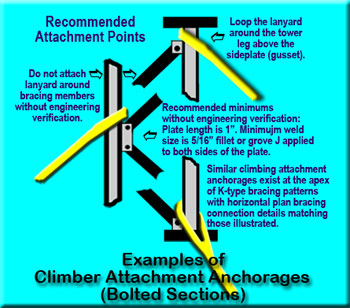 should be responsible for identifying safe anchorage locations on their assembly drawings; however, many industry professionals believe that riggers would be better served if examples were provided in a standard rather than trying to locate drawings from a manufacturer who is no longer in business or from a fabricator that might not be compliant with design requirements. should be responsible for identifying safe anchorage locations on their assembly drawings; however, many industry professionals believe that riggers would be better served if examples were provided in a standard rather than trying to locate drawings from a manufacturer who is no longer in business or from a fabricator that might not be compliant with design requirements.
Climbing facilities information, barely a half page of resource in Revision F, has been expanded to six pages in Rev G to ensure that worker safety is addressed.
Rev G classifies climbing and working facilities into two categories based upon the type of climber the product will be used by. A competent (skilled) climber is detailed as an individual with the physical capabilities to climb, has actual climbing experience and training in fall protection regulations including the equipment that applies to the field and who is capable of identifying existing and potential fall hazards; and who has the authority to take prompt corrective action to eliminate those hazards; and who is able to climb safely a structure away from fixed access routes. 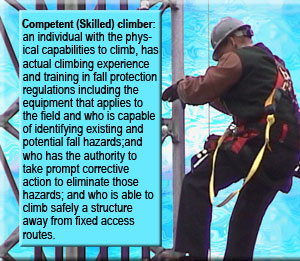
An authorized basic climber is described as an individual with the physical capabilities to climb who may or may not have previous climbing experience but has training in fall protection regulations, the equipment that applies to the field including instruction for their proper use; able to climb designated fixed access routes equipped with safety climb devices.
Unless otherwise required, the standard requires antenna supporting structures exceeding ten feet in height and antennas intended for climbing to be equipped with at least one climbing facility equipped with a safety climb device. If the safety climb device cannot be continuous over the entire height of the structure, there must be climber attachment anchorages available at a maximum spacing of four feet.
Since some climbing and safety climb devices can adversely affect the performance of an antenna the standard says that they need not be installed over the entire height of the structure; however, it should be equipped with a warning sign or have climber attachment anchorages at a maximum spacing of four feet.
A safety climb device is not required for each climbing facility when multiple climbing facilities are provided, but a device must be available for the climbing facility that is continuous over the height of the structure.
In order to minimize safety sleeve size requirements for cable support systems, a 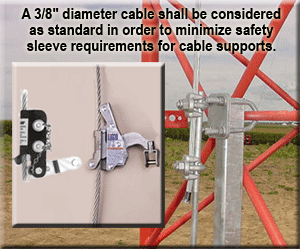 3/8" diameter cable is being required as the standard size.The standard recommends not using a ladder cage and hoops since communication structures need to be serviced at various locations. If they are provided, a separate safety climb device is not required. 3/8" diameter cable is being required as the standard size.The standard recommends not using a ladder cage and hoops since communication structures need to be serviced at various locations. If they are provided, a separate safety climb device is not required.
For interior ladders, a minimum clearance of 24 inches must be provided from the center line of the climber facility to any obstruction on the climbing side.
New dimensional requirements of climbing facilities will make it easier and safer for the rigger. The center-to-center spacing between rungs, alternately spaced step bolts, or structural members used for climbing must be ten inches minimum and 16 inches maximum. Minimum spacing used to be 12 inches. Step bolts previously had a maximum of 18 inches. The standard also identifies the horizontal distance between step bolts, placing it at 24 inches. In the past, some step bolts were installed on structures at three feet or wider, creating a difficult and sometimes unsafe climbing experience.
Handrails are required for platforms where climber attachment anchorages are not provided. Toe boards are not required. Structures that do not meet the requirements of the new climbing facilities standard must be equipped with warning signs.
The standard can be ordered through http://www.tiaonline.org at a price of $831.00. It's a wise investment for companies that earn their living from the design, manufacture, erection and maintenance of communications towers and accessories.
For additional information regarding safety, contact the following safety trainers and safety suppliers.
Copyright © Wireless Estimator, Inc. Please request reprint permission.
NOTE: This generic, non-exhaustive overview is intended to serve as a useful starting point for research and analysis of the topics addressed. Proper training,
 professional knowledge and oftentimes licensing are required prior to anyone providing product design, selection, installation, and construction/development-related activities. This information is neither presented to instruct nor teach anyone in the proper or safe methods of any aspect of wireless design or construction. To ensure minimum exposure and to determine compliance for a safe working environment, you must obtain the advice and guidance of an industry professional. professional knowledge and oftentimes licensing are required prior to anyone providing product design, selection, installation, and construction/development-related activities. This information is neither presented to instruct nor teach anyone in the proper or safe methods of any aspect of wireless design or construction. To ensure minimum exposure and to determine compliance for a safe working environment, you must obtain the advice and guidance of an industry professional.
WARNING: Failure to meet these minimum requirements and appropriate compliance responsibilities can result in serious injury or death to you or your fellow workers. All aspects of wireless construction are hazardous by nature. You have the sole responsibility to act safely and with caution prior to performing any construction-related task. your fellow workers. All aspects of wireless construction are hazardous by nature. You have the sole responsibility to act safely and with caution prior to performing any construction-related task.
Update: 1.20.2015
|